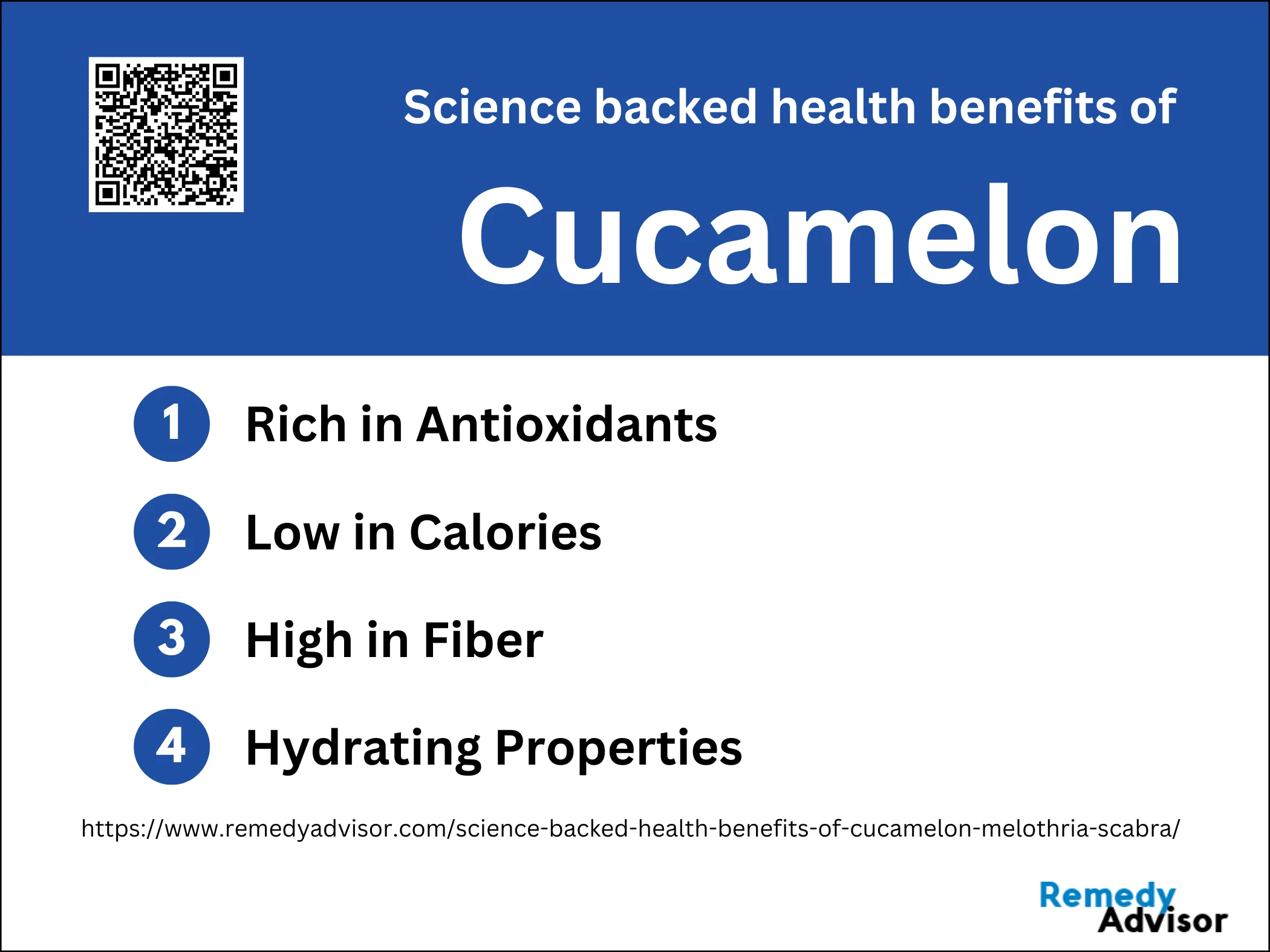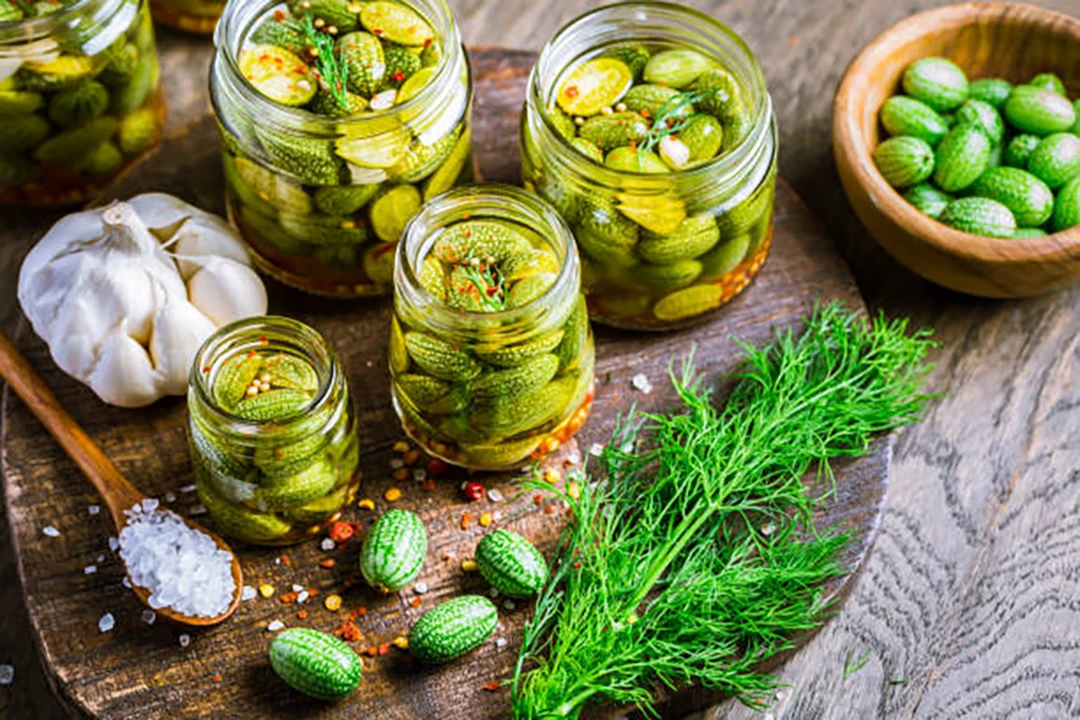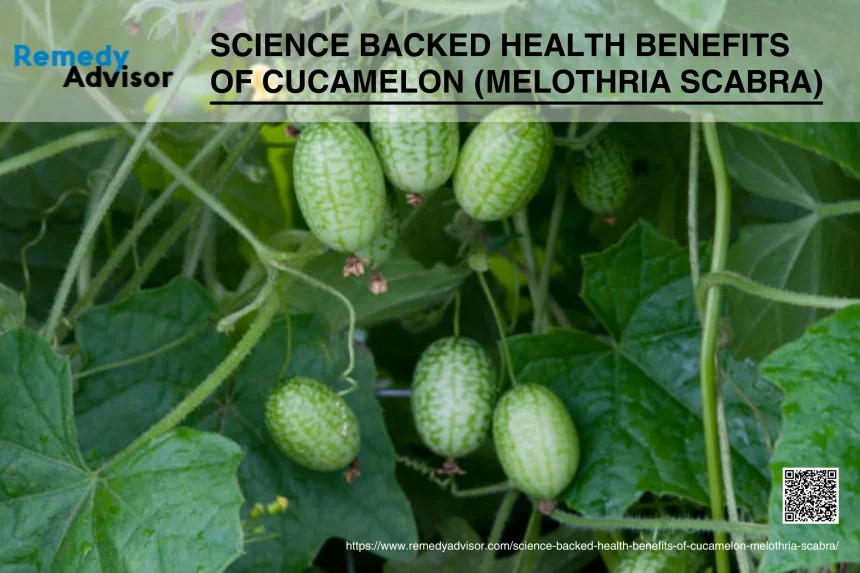Cucamelon, scientifically known as Melothria scabra, is a unique fruit that has been gaining popularity not just for its adorable appearance but also for its impressive health benefits. Resembling tiny watermelons, these grape-sized fruits pack a powerful nutritional punch. Native to Mexico and Central America, cucamelons have been a staple in traditional diets for centuries. They are rich in essential nutrients like vitamins C and A, potassium, and fiber, which contribute to their numerous health benefits. From boosting immune function to promoting heart health and aiding in digestion, cucamelons are a nutrient-dense superfood worth adding to your diet. In this article, we will delve into the science-backed health benefits of cucamelon and explore how this tiny fruit can make a big impact on your well-being.
What is Cucamelon ?
Cucamelon, also known as Mexican sour gherkin, is a climbing, herbaceous perennial plant belonging to the Cucurbitaceae family. This plant is notable for its small, cucumber-like fruits that have a slightly sour taste, making them popular in various culinary applications. Beyond its culinary uses, M. scabra has significant medicinal potential, as it contains a variety of phytochemicals such as terpenoids, saponins, tannins, steroids, carotenoids, glycosides, and resins, which contribute to its health benefits, including antidiabetic properties. Recent research has also explored the potential of artificial polyploidization to enhance the morphological, physiological, and biochemical characteristics of M. scabra, demonstrating improvements in nutritional content and antioxidant properties. Despite its growing popularity and economic importance, M. scabra remains an understudied crop, presenting numerous opportunities for further agronomic research to better understand its genetics, physiology, and morphology.
Nutritional Profile of Cucamelon
Cucamelons are a nutrient-dense fruit that offers a variety of essential vitamins, minerals, and other beneficial compounds. This unique fruit is not only low in calories but also rich in several key nutrients that contribute to overall health.
Overview of Key Nutrients
Cucamelons contain a diverse range of nutrients that support various bodily functions. They are particularly noted for their high water content, which aids in hydration, and their significant fiber content, which promotes digestive health. Additionally, cucamelons are a good source of vitamins and minerals that are crucial for maintaining optimal health.
Vitamins (e.g., Vitamin C, Vitamin A)
Cucamelons are rich in vitamins, particularly vitamin C and vitamin A. Vitamin C is a powerful antioxidant that supports immune function, skin health, and collagen production. It also helps in the absorption of iron from plant-based foods. Vitamin A is essential for vision, immune function, and skin health. These vitamins play a vital role in protecting the body against oxidative stress and supporting overall health.
Minerals (e.g., Potassium, Magnesium)
Cucamelons are a good source of essential minerals such as potassium and magnesium. Potassium is crucial for maintaining healthy blood pressure levels and proper muscle function. It also helps in balancing fluids in the body. Magnesium is important for muscle and nerve function, blood sugar control, and bone health. These minerals contribute to the overall well-being and proper functioning of the body.
Fiber Content
Cucamelons are high in dietary fiber, which is important for digestive health. Fiber helps regulate bowel movements, prevent constipation, and maintain a healthy gut microbiome. It also aids in controlling blood sugar levels and can help in weight management by promoting a feeling of fullness. The fiber content in cucamelons makes them an excellent addition to a balanced diet.
Antioxidants
Cucamelons are packed with antioxidants, including polyphenols and flavonoids, which help protect the body from oxidative stress and reduce inflammation. Antioxidants neutralize free radicals, which can cause cellular damage and contribute to chronic diseases such as cancer, heart disease, and diabetes. The antioxidant properties of cucamelons support overall health and help in preventing various health conditions.
Science backed health benefits of Cucamelon
Cucamelon is a unique fruit that resembles a tiny watermelon but tastes like a cucumber with a hint of lime. This fruit is not only interesting in appearance and taste but also packs several health benefits. Here are some of the key health benefits of cucamelon:

1. Rich in Antioxidants
Cucamelons are rich in antioxidants, which help combat oxidative stress in the body. Antioxidants are essential for neutralizing free radicals, which can cause cellular damage and contribute to various chronic diseases, including cancer and heart disease.
2. Low in Calories
One of the most appealing aspects of cucamelons is their low-calorie content. This makes them an excellent snack for those looking to manage their weight without sacrificing flavor or nutritional value.
3. High in Fiber
Cucamelons are a good source of dietary fiber, which is crucial for maintaining a healthy digestive system. Fiber aids in digestion, helps prevent constipation, and can contribute to a feeling of fullness, which can aid in weight management.
4. Hydrating Properties

Like cucumbers, cucamelons have a high water content, which helps keep the body hydrated. Proper hydration is essential for maintaining healthy skin, regulating body temperature, and supporting overall bodily functions.
How to Incorporate Cucamelon into Your Diet
Incorporating cucamelons into your diet is a delightful way to enjoy their unique flavor and numerous health benefits. These tiny, grape-sized fruits, which taste like a tangy cucumber with a hint of lime, can be eaten raw, pickled, or added to various dishes. They are rich in vitamins, minerals, and antioxidants, making them a nutritious addition to your meals. Try adding them to salads, salsas, and smoothies, or simply snack on them fresh from the garden. Their versatility and refreshing taste make them a fun and healthy ingredient to experiment with in your kitchen.
Tips on Selecting and Storing Cucamelon
When selecting cucamelons, look for firm, unblemished fruits about the size of a grape. Avoid any that are soft or yellowing, as these are overripe. To store cucamelons, place them in a perforated plastic bag or a container with a lid in the refrigerator, where they will keep for just over a week. For longer storage, cucamelons can be pickled or frozen. To freeze, wash and dry the fruits, then spread them out on a baking sheet to freeze individually before transferring them to airtight containers or freezer bags.
Simple Recipes and Serving Suggestions

Cucamelons can be enjoyed in a variety of simple recipes and serving suggestions. They can be eaten raw, added to salads, or pickled for a tangy snack. Cucamelons also make a great addition to salsas, providing a refreshing crunch. For a quick and easy snack, try dipping them in hummus or your favorite dip. They can also be used as a garnish for cocktails, adding a unique twist to your drinks. Their versatility makes them a fun ingredient to experiment with in the kitchen.
Salads
Cucamelons add a refreshing crunch to salads, making them a perfect addition to your summer dishes. Try combining them with cherry tomatoes, sweet peppers, leafy greens, and fresh herbs like basil and parsley. For a more substantial salad, add mozzarella balls and a light vinaigrette. Cucamelons can also be marinated in rice vinegar with tomatoes and peppers for a tangy side dish. Their unique flavor pairs well with a variety of ingredients, making them a versatile addition to any salad.
Pickles

Pickling cucamelons is a great way to preserve their tangy flavor and enjoy them year-round. To make pickled cucamelons, combine water, apple cider vinegar, white vinegar, salt, and sugar in a pot and bring to a simmer. Pack the cucamelons into sterilized jars with garlic, dill, and pickling spices, then pour the brine over them. Seal the jars and refrigerate for at least a week before enjoying. Pickled cucamelons make a delicious addition to salads, sandwiches, and charcuterie boards.
Smoothies
Adding cucamelons to smoothies is a refreshing way to enjoy their hydrating properties and nutritional benefits. Their mild, tangy flavor pairs well with a variety of fruits and vegetables. Try blending cucamelons with spinach, cucumber, pineapple, and a splash of coconut water for a hydrating green smoothie. For a sweeter option, combine cucamelons with strawberries, banana, and almond milk. Their high water content and unique flavor make them a great addition to any smoothie recipe.
Snacks
Cucamelons make a delightful snack on their own or paired with other ingredients. Enjoy them fresh from the garden, or dip them in hummus or guacamole for a healthy snack. They can also be added to cheese and charcuterie boards, providing a refreshing contrast to richer flavors. For a quick appetizer, try cucamelon bruschetta: top toasted bread with chopped cucamelons, tomatoes, basil, and a drizzle of balsamic glaze. Their versatility and refreshing taste make them a perfect snack for any occasion.
Side effects of eating cucamelon
Here are individual paragraphs on potential side effects of eating cucamelon:
Allergic Reactions
While rare, some individuals may experience allergic reactions to cucamelons, especially those with existing allergies to cucumbers or watermelons. Symptoms of an allergic reaction can include itching, swelling, hives, or difficulty breathing. If you have known allergies to fruits in the Cucurbitaceae family, it’s advisable to consult with an allergist before incorporating cucamelons into your diet.
Digestive Issues
For some people, particularly those with sensitive digestive systems or conditions like irritable bowel syndrome (IBS), consuming cucamelons may lead to gastrointestinal discomfort. The fruit’s acidic nature could potentially trigger or exacerbate symptoms of gastroesophageal reflux disease (GERD) or chronic acid reflux. If you have a history of digestive issues, it’s best to introduce cucamelons gradually into your diet and monitor your body’s response.
Kidney Stone Risk
Individuals prone to kidney stones or those on a low-oxalate diet should exercise caution when consuming cucamelons. Like many fruits and vegetables, cucamelons contain oxalates, which can contribute to the formation of kidney stones in susceptible individuals. If you have a history of kidney stones, it’s recommended to consult with a healthcare professional or registered dietitian before adding cucamelons to your regular diet.
Medication Interactions
The high potassium content in cucamelons may interact with certain medications, particularly those that affect potassium levels in the body. This includes some blood pressure medications and potassium-sparing diuretics. If you’re taking any medications, especially those that influence electrolyte balance, it’s crucial to discuss with your healthcare provider or pharmacist whether consuming cucamelons could potentially interfere with your medication regimen.
Conclusion
In conclusion, cucamelons offer a unique blend of flavor, versatility, and health benefits that make them a valuable addition to any diet. These tiny fruits pack a nutritional punch with their high content of antioxidants, vitamins, minerals, and fiber, while remaining low in calories. Their hydrating properties and potential to support digestive health further enhance their appeal. Cucamelons can be easily incorporated into various dishes, from salads and smoothies to pickles and snacks, providing a refreshing crunch and tangy flavor. While generally safe for consumption, it’s important to be aware of potential side effects, particularly for those with allergies, digestive sensitivities, or specific health conditions. As with any dietary change, moderation and consultation with a healthcare professional are advised. Overall, cucamelons present an exciting opportunity to diversify one’s diet while reaping numerous health benefits.
ADDITIONAL RESOURCES
Here are some US organizations involved in research on fruits, along with their short descriptions and URLs:
Wholesome Wave is dedicated to ending food and nutrition insecurity across America by increasing the affordability and access to fresh produce. They focus on innovative initiatives like doubling SNAP benefits for fruits and vegetables and writing prescriptions for produce in clinical settings to promote long-term health and wellness.
2. Appalachian Fruit Research Station (AFRS)
Part of the USDA Agricultural Research Service, AFRS conducts fundamental, applied, and developmental research on critical problems of temperate fruit production. Their work includes enhancing germplasm through molecular and traditional breeding techniques, developing cost-efficient cropping systems, and protecting fruit crops using biological control and environmentally friendly materials.
3. org
This website provides evidence-based updates on the latest nutrition research, including studies on the health benefits and potential risks of fruit consumption. It emphasizes the importance of dietary diversity and the unique combination of phytonutrients in various fruits.
PLOS Medicine publishes research on the health impacts of fruit and vegetable consumption. One notable study examined the long-term effects of increased fruit and vegetable intake on weight change among US men and women, providing insights into the benefits of specific fruits and vegetables.
Recommendations for books on Cucamelons
Here are some recommendations for books on research related to Cucamelons:
1. “Melothria scabra: Tiny, Yet Mighty” by Maria E. Vasquez
This book delves into the botanical characteristics, nutritional benefits, and potential uses of Cucamelons, offering insights from recent scientific studies.
FAQS
- What are the primary nutrients found in cucamelons?
Cucamelons are rich in essential nutrients such as vitamin C, potassium, magnesium, and dietary fiber. They also contain antioxidants like lycopene and flavonoids, which contribute to their health benefits.
- How do cucamelons support immune function?
Cucamelons are high in vitamin C, which is known to boost immune function by neutralizing free radicals, reducing inflammation, and enhancing the body’s ability to fight infections.
- Can cucamelons help with hydration?
Yes, cucamelons have a high water content, making them an excellent choice for maintaining hydration. This is particularly beneficial during hot weather or after physical activity.
- How do cucamelons benefit heart health?
Cucamelons contain potassium, which helps lower blood pressure by counteracting the effects of sodium and relaxing blood vessels. This can reduce the risk of cardiovascular diseases such as hypertension, heart attacks, and strokes.
- Are cucamelons good for digestive health?
Yes, the dietary fiber in cucamelons aids digestion by adding bulk to stool, promoting regular bowel movements, and preventing constipation. This can also reduce the risk of digestive conditions like irritable bowel syndrome.
- Can cucamelons aid in weight management?
Cucamelons are low in calories but high in fiber, which can help regulate appetite by promoting feelings of fullness. This makes them a great addition to a weight loss or weight management plan.
- Do cucamelons have any benefits for skin health?
The antioxidants in cucamelons, especially vitamin C, help protect the skin from oxidative damage, promote collagen synthesis, and improve overall skin health.
- How do cucamelons support bone health?
Cucamelons contain magnesium, which is essential for bone formation and the assimilation of calcium into the bone. This can help maintain bone density and reduce the risk of osteoporosis.
- Are there any potential side effects of eating cucamelons?
Generally, cucamelons are safe to eat in normal food amounts. However, if you experience any allergy symptoms like a rash or throat tightness, it is advisable to avoid them and seek medical care if necessary.
- How can cucamelons be incorporated into a diet?
Cucamelons can be eaten raw, added to salads, salsas, or pickled. They are versatile and can be used in various dishes to add a tangy, sour flavor.







